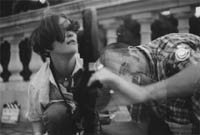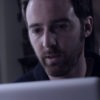
Creating Space for Experimental Film
Written by Tiffany Patrick | Posted by: Anonymous
TP: Tell me how you two met.
Kovgan: In 1997, I believe. I had been in the US for only one year. I was quite busy at that time — filming music shows, studying film with John Gianvito at UMASS, doing my Master’s degree in Education and working at MIT Video Production and Distance Learning. I was in the process of making my first 16mm film and was looking for a collaborator. Jeff was at the crossroads at that time. He had just come back from his trip around Latin America and was working on a film about his journey.
Silva: We were both full of ideas and creative energy so we began helping each other to complete our projects and make new ones. We’ve worked on countless projects since then.
TP: I’m going to assume that you don’t just decide to collaborate on a film series with everyone you meet. Describe how you both came to be partners as curators of the Balagan Experimental Film and Video Series.
Silva: After we finished helping each other with our movies we were excited to show them to people. We had difficulty finding any places that were truly interested in showing experimental films so rather than putting them on a shelf and forgetting about them we started to create our own shows around town in Allston, Cambridge, Somerville, etc. Since our works were shorts, we wanted to round out our programs in order to make it worthwhile and long enough to attract a public audience. So we started contacting other filmmakers whose works we appreciated and related to and showed them as a group of experimental films. It started rather haphazardly but evolved over time and practice into something we took very seriously.
We learned, as in film editing, that an image (or in this case a complete film) influences the viewers’ perception of the image (or film) next to it. So each show has a certain dynamic, rhythm and concept. Now we are showing many more filmmakers’ works than we ever imagined and not so much of our works, but it is an opportunity for us to give back to the film community and to share with film buffs some of the amazing local film/video works we’ve encountered that are deserving of exhibition.
Kovgan: Besides making films and organizing shows together, we have also collaborated with different musicians and dancers doing live video projections. As a result, we have formed the PIXONIK Labs collaborative. PIXONIK Labs is another side of our ‘visual’ life, I guess. Besides being avid lovers of the film medium, we also explore video and its forms. In collaboration with musicians, other film/video artists and a quilt maker, we did two shows at Mobius in 1999 ‘We are all targets’ and ‘Misguided Again’. ‘Misguided Again’ was an hour-long show with 3 simultaneous video projections and live sound. This show was quite complicated to orchestrate. But somehow we made it through. So when we decided to do Balagan, we had been through a lot together and knew each other quite well.
TP: What does your collaboration look like? How do you divide or share tasks?
Kovgan: We usually get works from many different sources — sometimes, through our personal contacts, sometimes through recommendations of other filmmakers or just random submissions. We watch most of the films we receive together to compile a program. Sometimes, one of us will focus on a particular program more, and it may happen that one of us or neither of us would be able see a film before the screening. Usually that is all right as we trust each other’s opinions and the opinions of others who recommend the films to us.
Silva: As for the PR and Administrative stuff, I tend to do press releases, while Alla does all the web design, graphics and programs. We try to share in the fun stuff and split the not-so-fun stuff. There’s tons more not-so-fun stuff to do in order to make the series happen then we had imagined.
TP: You will be celebrating your first anniversary of the Balagan Experimental Film & Video Series at the Coolidge Corner Theatre, a theater that has strong community ties and one that has a rich history. How does the theater impact the Series? Would it be the same series somewhere else?
Silva and Kovgan: The Coolidge is a wonderful venue to be associated and working with. Showing experimental films is a natural addition to the challenging and progressive programming that already happens there on a day-to-day basis. Joe Zina and Clinton McClung have been extremely supportive of our efforts. One of the nice things about the Coolidge is that it is an established cinema so it makes it easier to get people to come to our shows who wouldn’t ordinarily come. Perhaps what brings us the most satisfaction in programming the Balagan series is the wonderful interactions, questions and reflections that tend to occur after the screenings between filmmakers, the audience members and ourselves. The new Screening Room creates this comfortable and intimate space that allows for this kind of casual dialogue that usually isn’t present in other venues. If Balagan were somewhere else the programming would still be the same but the atmosphere would certainly change.
TP: You mention experimental film and video makers struggling to find venues to exhibit their work. Has that always been the case? I’ve often asked filmmakers if New England is filmmaker friendly. I’ll revise that and ask, is New England a friend of experimental film and video?
Jeff and Kovgan: New England has a strong and extremely diverse community of experimental filmmakers but many of them are unknown outside of the experimental circle. The universities around New England house some of the countries finest filmmakers who don’t make movies for commercial profit. New England is better than most US cities as a friend of experimental film, but if you look at European filmmakers who make short and experimental films, and the support that they receive, we would say Boston has a ways to go. Most people aren’t aware of the pool of talent that has gathered in the New England area over the years. There is a lot to see and experience through other kinds of films and videos that exist. These unconventional works can expand the definition of what the film/video medium is or what it can be as an art form and as a way of expression.
The local audience that has been exposed to experimental film/video is extremely friendly and receptive to this type of work. But chances for someone to view these works are rather slim. Besides creating regular venues to exhibit short films, it would be great if some other local movie theatres followed the Coolidge Corner Theatre and established a "short before the feature" series — while local TV stations could incorporate short film programs in their broadcast schedule.
TP: In March of last year NewEnglandFilm.com covered an event at the Harvard Film Archive called Short and Edgy. Several of the women, in fact, who shared their work at that program, are having their work showcased with you on March 1. What struck me about Short and Edgy was the effect which one program had on the next and then the next. Describe how you went about putting the spring season together. Twelve evenings seems like a life’s work. When did you start planning the spring series and how did you end up with the Spring 2001 line-up?
Jeff and Kovgan: We are not sure exactly how we ended up with 12 programs for this season. We were both so exhausted by last year’s 8-week series that we made an effort to slow down, but somehow got caught up in the moment of The Balagan again! We had many ideas left over from the fall season so we’ve decided to add them to the spring series, such as the "Director’s Eye" series. Some of our best shows, however, are curated by other film/video makers. For instance, the animation program is put together by local animator Jeff Sias. Jeff is much more aware of what is going on amongst the local animators and we are happy to host his program. We are trying to move more into the arena of bringing in guest curators whom we trust to maintain a high level of quality and retain the essence of the Balagany experience. This year we are bringing Alberto Roblest’s programs of Experimental Videos from Mexico on March 15th, Jeff Sias’ second animation program on April 12th and Joel Bachar’s "Independent Exposure" program on May 17th that is part of the exciting Microcinema movement of Blackchair Productions.
TP: Can we expect a fall series? Any ideas on where you want to take that?
Jeff and Kovgan: We hope so. Only time will tell. What continues to keep us going and inspires us to continue next year is the enthusiasm and genuine appreciation that the filmmakers themselves have expressed to us for bringing this series to life. We are filmmakers first and curators second so we will have to evaluate how much time and energy we can afford to keep the series going. But we will try to find ways to continue Balagan in the fall and beyond.
For a complete schedule of the Balagan Experimental Film Series at the Coolidge Corner Theatre, log on to http://www.coolidge.org/balagan/ or e-mail Alla Kovgan or Jeff Silva at balaganfilms@hotmail.com.









